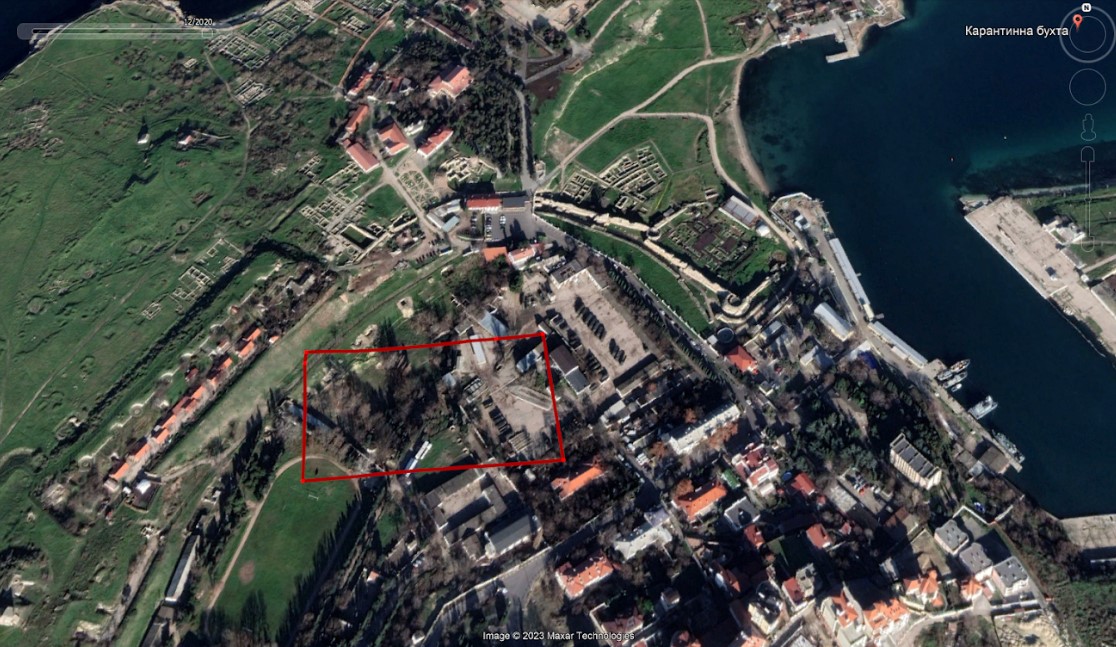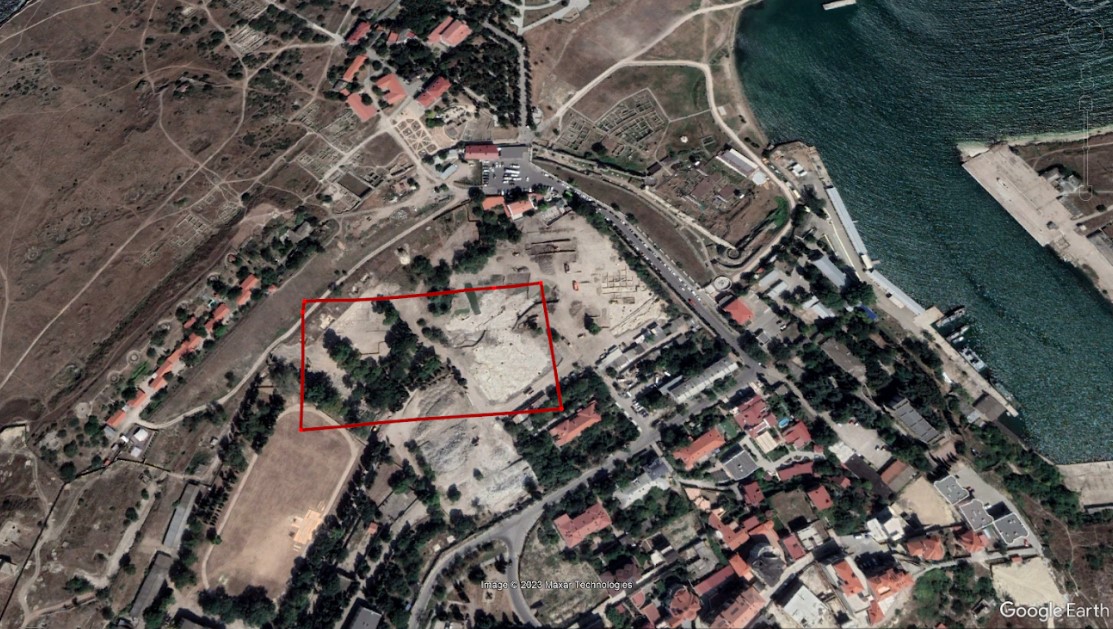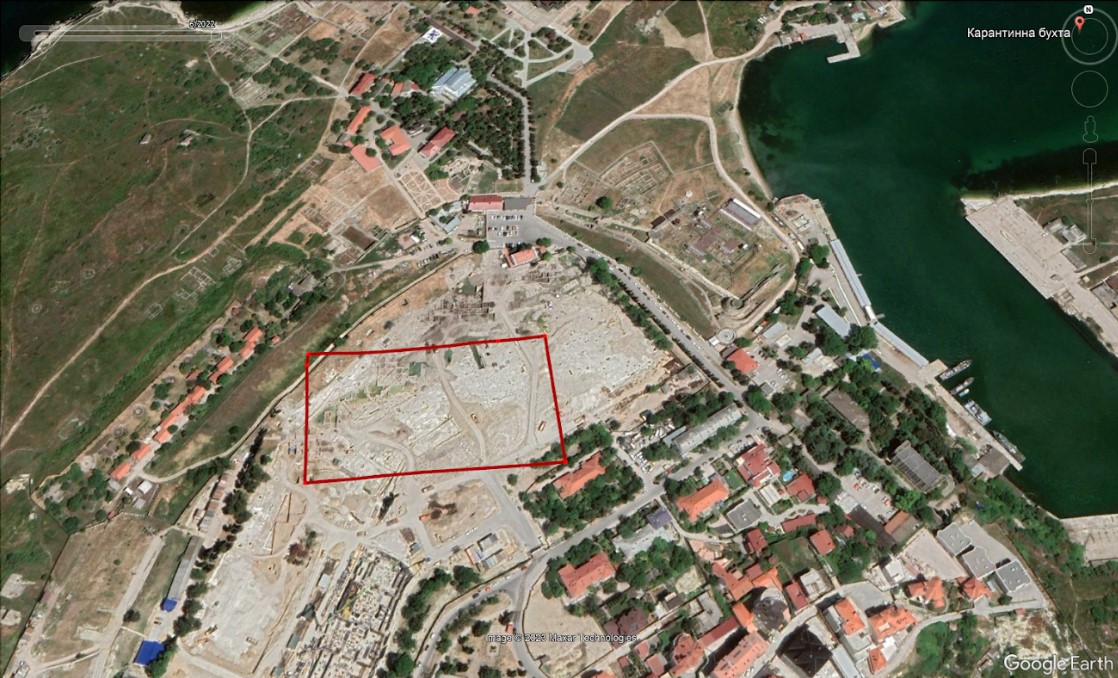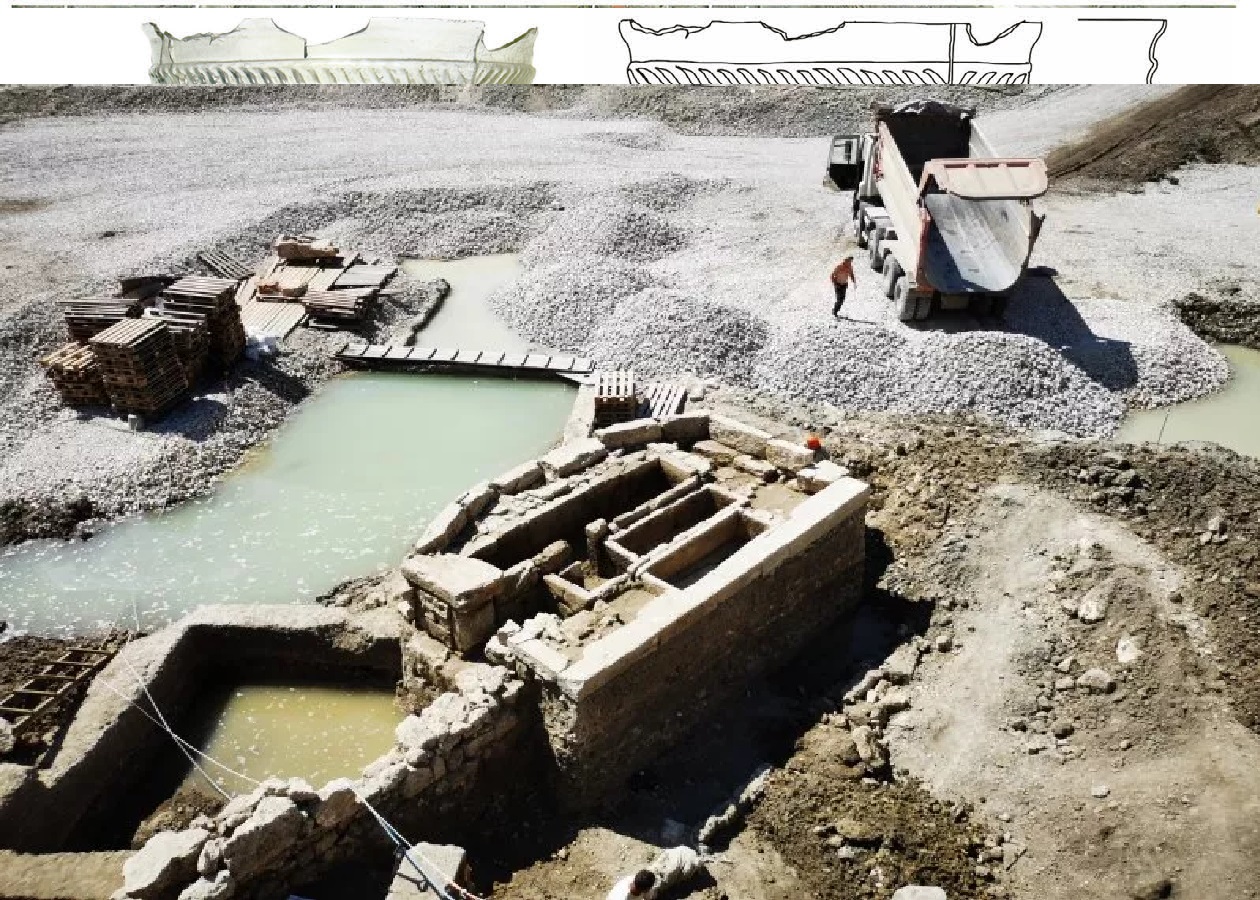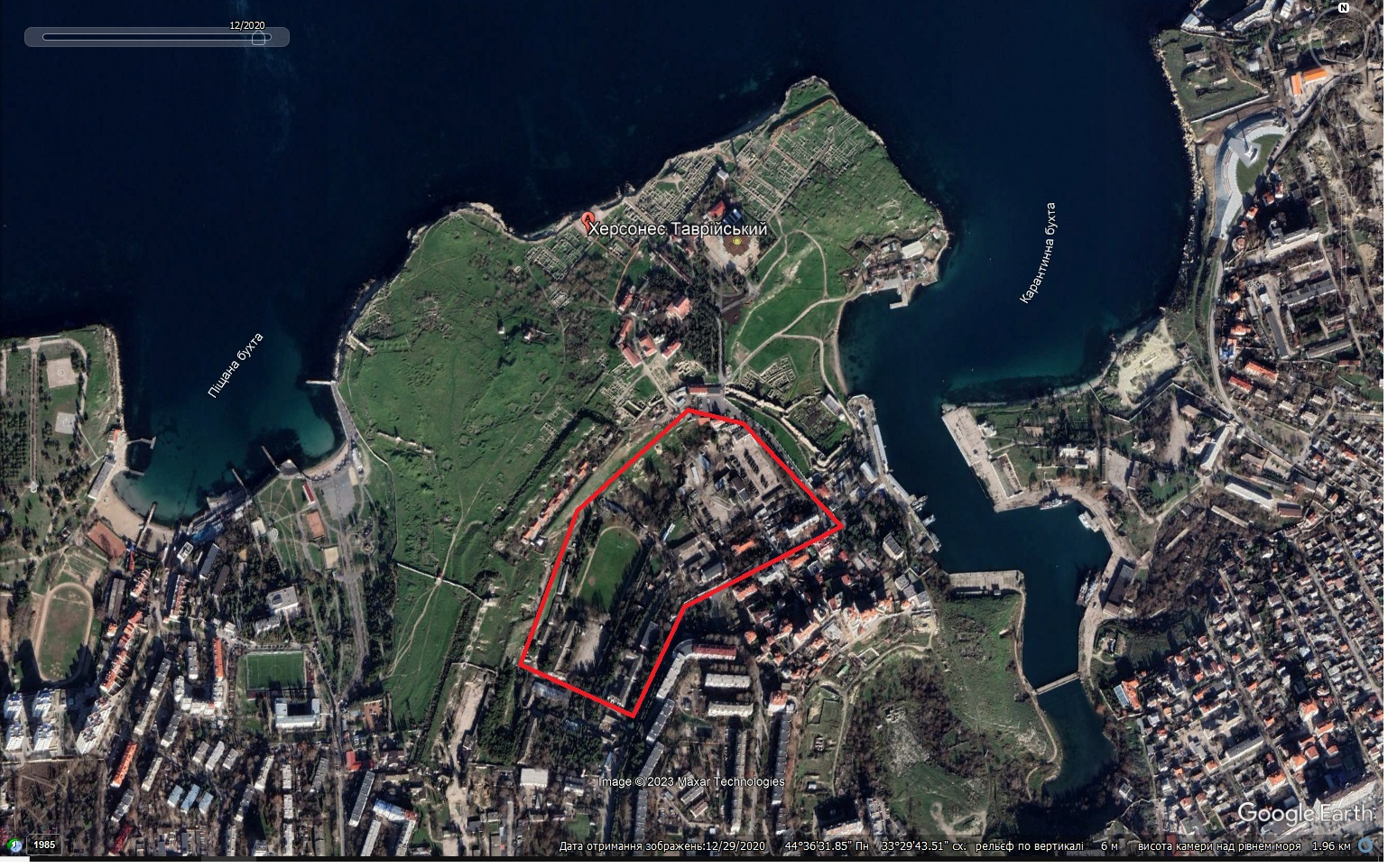General information
Location
City - Sevastopol city
Autonomous Republic of Crimea
Kind of cultural heritage
ArchaeologicalObject type
ComplexesViolation type
Illegal archaeological excavationsMap
Object history and violation description
INFORMATION UPDATED
Chersonesus is the cornerstone of Crimean history. On the one hand, it is a site that embodies the penetration of civilization into Crimea and its transformative effect on the local barbaric environment, which turned into a genuine ancient society. It tells a story of the real Hellenes, the power of Roman emperors and legions and Byzantine intrigues. On the other hand, Chersonesus is a case of the great creative potential of the local barbarians, the story of their ability to take the best from the outside without losing themselves. Here, pride of place belongs to the Cumans with their steppe culture in the very heart of the sanctuary of any city – the artisan quarters, and the proto-Bulgarians, who deeply infiltrated the Byzantine bureaucracy and nobility, the Circassian masters of Mangup, seeking to bring the dead city back to life. This wonderful and complex history of the ancient city is lost in the classical sense: time has deprived us of its chronicles. Therefore, the archeology of Chersonesus is its comprehensive fossilized chronicle.
The ruins of Tauric Chersonesus are located on the shore of the modern Karantynna (Chersonenus) Bay in Akyar-Sevastopol. The ancient city is a walled promontory of more than 40 hectares with a single complex of suburban infrastructure in the form of ancient necropolises, pottery workshops with large-scale furnace complexes, suburban monasteries and the city posad. Unfortunately, a large part of the suburban territory, located behind its defensive wall and blocked by the continuous urban development of the Gagarin district of Akyar-Sevastopol, has been systematically destroyed since the end of the 18th century.
In 2020, the territory of Tauric Chersonesus de facto increased by 13 hectares. For this purpose, military units (automotive battalions and a divers’ school), immediately adjacent to the walls of the museum-reserve, were liquidated. On the vacated territory, the occupation authorities plan to build a complex consisting of museum infrastructure (administrative buildings, ancient, medieval and Christian halls), premises of the Artek children’s center, general education and art schools, and a hotel complex. In ancient times, this was the southern suburb of Chersonesus. As a result of research on the site at the end of the 19th and the early 20th centuries, a large necropolis (called “southern”) and pottery workshops of the Hellenistic era were found here. In the mid-20th century, a pottery workshop – according to the conclusion of archaeologists, also Hellenistic – was traced further west from the walls of the Citadel of Chersonesus. In the early 2000s, it could already be stated that the necropolis comprised Roman and medieval sections.
Chersonesus was founded in 422–421 BC. The possible date of birth of the city is 533–532 BC. During its existence, Chersonesus experienced at least one large-scale dereliction around the 11th century, when its territory was catastrophically reduced to such an extent that a large pottery workshop was located in front of the main temple of the entire Chersonese metropolis (usually such craft centers were located on the outskirts). Having experienced its last rise and prosperity in the 12th–13th centuries, the ancient city fell into decline at the end of the 13th century. It lost its urban appearance somewhere in the first half of the 14th century. However, in the 15th century on the castle of the rulers of Theodoro was located here, which symbolized in the medieval society of the southwest Crimea an inseparable historical connection and political continuity between Mangup and Chersonesus. Despite the final demise of all the settlements on the site of the ancient city no later than the 3rd quarter of the 15th century, it was still remembered as Ierizon – amazing ruins and a pier – until the end of the 18th century, when Akyar-Sevastopol was founded.
Nowadays, Chersonesus consists of ruined defensive walls, city quarters (at least 100), sanctuaries, pagan temples, basilica churches, cross-domed and quarter churches, monasteries, synagogues, quarter cemeteries, wineries, shops, taverns, inns, almshouses, craft workshops. and a port.
The occupation had a detrimental effect on the scientific exploration of Chersonesus. It is no exaggeration to say that the main research center of the ancient city — the Chersonesus National Reserve — has practically lost its scientific archaeological school. In 2014, the latest (already illicit) excavations took place in the northern part of the settlement (Quarter IX “A”). In 2015, attempts to resume research in the Central District (quarter XL, explored by the Polish-Ukrainian expedition) in the new occupation realities proved futile. Since 2016, sporadic scientific work has been carried out on the territory of the quarter in the Southern Gate and the Southern Necropolis. In 2017, the same works were carried out in quarter L (previously explored by the American-Ukrainian expedition). The “old school” was replaced by an expedition of the State Hermitage Museum (quarter XX) and an underwater archaeological expedition of the museum-reserve itself was formed.
At the same time, the ancient city, a UNESCO site, is exposed to active “rescue” archeology: simply put, illicit excavations “for demolition” are being carried out on its territory. These include projects of capital site improvement, both of the settlement itself (in 2018, the necropolis in tower I and the peribolos (an enclosed court) in the Zeno tower; in 2019, the Citadel), and in the immediate surrounding area (2016 – the western suburban necropolis; 2017 – the necropolis in the Pisochna Bay; 2019 – the cemetery of All Saints or the necropolis on Maiden’s Hill; 2020–2021 – city suburbs in the Chersonese gully).
Another no less important factor in the destruction of Chersonesus is the museification and restoration projects at the site. The Opera in Chersonesus project is an example of the museification projects. Within its borders, a stage, an open audience hall, and theatrical lighting and sound equipment are installed every summer on the territory of the Citadel and the Port quarter. Such buildings have a scale incomparable not only with ancient and medieval ruins of city manors and defensive walls but also with the monumental St. Volodymyr's Cathedral, which against their background is perceived as a small toy. As a result, in about a month, the landscape of the ancient city in the Port area changed beyond recognition and lost its historical integrity. The annual installation and dismantling of such a volume of equipment places an excessive burden on archaeological remains. In 2018, the western defensive wall in the Citadel was “restored” in a short period of time. The haste of the works and their local character, however, cast doubt on their ability to completely eliminate the danger of loss of archaeological objects during the festival.
The biggest losses to the archaeological heritage of Chersonesus were caused by the illicit “excavation” of its suburbs “for demolition” in 2020–2021. Russian archaeologists faced the task of clearing the site for the construction of objects from the “wishlist” of the Russian Orthodox Church and President Putin of Russia. The territory, on which large-scale construction work is currently underway, has been under close scrutiny of Chersonesus researchers since the very moment the museum was founded at the end of the 19th century. That said, due to the location of military facilities here, its exploration was sporadic.
In the end, despite the scale of the works, the most vivid and valuable finds still come from other areas of exploration, where excavation methods continue are still abided by. For example, in 2018, a unique chalcedony stamp from the late 4th – early 3rd century BC was discovered in quarter XX, which belonged to the Chersonesian official Heraclius. Such stamps were used, in particular, for branding amphorae and tiles. In 2015, a molybdovul from the mid-11th century was found in quarter XCVII (a merchant lead seal for personal, diplomatic and state correspondence) that belonged to Leo Aliatas, the strategos (military general) of the Chersonesus and Sugdeia thema (military and administrative division). The value of the find lies in the fact that it indicates the exact title of the Byzantine official who ruled on the eve of the fall of the imperial rule in Chersonesus, southwest Crimea and then in the Northern Black Sea region in general and at the beginning of the so-called of the post-thema period — the time when local state power and agency started to emerge.
The main symbol of the destruction of Chersonesus in 2020 and 2021 was, of course, the excavator. Heavy construction equipment is used everywhere during excavations in the suburbs of the city. Large-scale work on a complex and multi-layered monument, even with the observance of excavation methods, is a challenge for the preservation of the object. That said, the situation is significantly complicated by accelerated development. The discussion as to whether the illegal excavations lead to the destruction of the suburbs of Chersonesus do not make sense. The main question is how significant these losses are.
There are two fundamental scientific questions in the history of Chersonesus, whose meaning determines the understanding of the entire historical process of the peninsula: when Chersonesus was founded and when the city perished. This is a considerable scientific problem. It is assumed that the last centers of life in the Chersonesian quarters were in the Port district. However, in the 19th and 20th centuries, its upper and most recent layers were heavily damaged (practically destroyed) by the Russian military. Therefore, despite the presence of lapidary findings with the coats of arms of the Theodoro rulers (which museum workers eventually lost), the cultural layers of the 15th century were never found in Chersonesus. The issue of the presence of the Theodorian fortress in Chersonesus is left hanging in midair. Therefore, the question of how the Theodorites treated this ancient city also remains unaddressed. Without it, there is a gap in our knowledge about the history of southwest Crimea, which prevents us from tracing the continuity between Chersonesus and the Crimean Khanate, the suzerain of the Mangup lords, which is increasingly evidenced by the study of their material culture. The southern suburbs are located as close as possible to the Port quarter and are its continuation; therefore, until 2020, it was hoped that the Theodorian Chersonesus would be discovered under the military units by using modern methods of thorough excavation. However, it is now obvious that a large part of these layers was destroyed by Russian bulldozers and excavators.
Ancient Chersonesus was left alone with catastrophic excavations “for demolition” and the development of monstrous structures on its territory. The occupation realities are such that the “authorities” responsible for cultural heritage protection are more motivated to free the territory from the UNESCO site as such than to preserve and museify it. This organically fits into the policy of erasing the ancient history of Crimea and replacing it with Russian colonial “resort” values.
Gallery
Additional files
- Orbis terrarum Byzantinus
- Archaeologists discovered a unique ancient gazebo with a mausoleum in Sevastopol - Rossiyskaya gazeta
Involved persons
- State Hermitage - Nadezhda Novosyolova
- the so-called National Prreserve of Tauric Chersonesos - Sergey Demyanchuk
- the so-called Institute of Archaeology of Crimea of the Russian Academy of Sciences - Sergey Ushakov
- - Ministry of Culture of the Russian Federation
- - The so-called Institute of Archaeology of Crimea of the Russian Academy of Sciences
- head of the so-called Chersonese Protective Archeological Expedition of the so-called Federal State Budgetary Institution of Science “Institute of Archeology of Crimea of the Russian Academy of Sciences” - Vladimir Vlasov
- - Institute of Archaeology of the Russian Academy of Sciences
- a leading research fellow of the Department of the History of Ancient Culture of the Institute for the History of Material Culture of the Russian Academy of Sciences (recipient of a permit to conduct archaeological works) - Yuriy Vinogradov
- a research fellow of the Department of Rescue Archeology of the Institute for the History of Material Culture of the Russian Academy of Sciences, PhD in History - Sergey Solovyov
- - My History Fund
- - Patriarchal Council for Culture of the Russian Orthodox Church
- - Institute for the History of Material Culture of the Russian Academy of Sciences
Video gallery
information is clarified
Sources
- Novosolova N.Yu. (2018). Arkheologicheskiye raskopki ekspeditsii gosudarstvennogo Ermitazha v KHKH kvartale Khersonesa Tavricheskogo. Arkheologicheskiye otkrytiya. 2016. Moscow: Institute of Archaeology of the Russian Academy of Sciences, p. 248-250;
- NOVOSELOVA N.YU. (2017). ARKHEOLOGICHESKIYE ISSLEDOVANIYA V KHERSONESE V 2015 GODU. Arkheologicheskiy sbornik. Issue 41: materialy i issledovaniya po arkheologii. Yevrazii. St. Petersburg: Izd-vo Gos. Ermitazha, p. 248-260.;
- Novosolova N.Yu. (2020). KHKH KVARTAL KHERSONESA TAVRICHESKOGO V VIZANTIYSKOYE VREMYA: ISSLEDOVANIYA EKSPEDITSII GOSUDARSTVENNOGO ERMITAZHA V 2019 GODU. Istoriya i arkheologiya Kryma. Issue 13. Sevastopol: Kolorit, p. 333-340.;
- Novosolova N.Yu. (2019). RABOTY EKSPEDITSII GOSUDARSTVENNOGO ERMITAZHA V KHERSONESE TAVRICHESKOM V 2018 g. Istoriya i arkheologiya Kryma. Issue 11. Sevastopol: Kolorit, p. 235-242.
- PROGRAMMA nauchno-prakticheskoy konferentsii po itogam polevogo arkheologicheskogo sezona 2017 g. v Krymu, posvyashchonnoy 70-letiyu Instituta arkheologii Kryma RAN i 100-letiyu so dnya rozhdeniya Elly Isaakovny Solomonik, Iriny Timofeyevny Kruglikovoy i Tatyany Vasilyevny Blavatskoy. Istoriya i arkheologiya Kryma. Issue 8. Sevastopol: Kolorit, p. 7-12.
- SEDIKOVA L.V. (2018). NOVYYE NAKHODKI POLIVNOY POSUDY XIII V. IZ RASKOPOK KHERSONESA. CHERSŌNOS THEMATA: imperiya i polis. X Mezhdunarodnyy Vizantiyskiy Seminar (Sevastopol' – Balaklava 28 May – 1 June 2018). Materialy nauchnoy konferentsii. Sevastopol, Simferopol: Kolorit, p. 183-185.;
- Sedikova L.V. (2018). RASKOPKI L-GO KVARTALA KHERSONESSKOGO GORODISHCHA. Istoriya i arkheologiya Kryma. Issue 8. Sevastopol: Kolorit, p. 108-109;
- Ushakov S.V. (2019). ISSLEDOVANIYA KVARTALA XCVII KHERSONESA TAVRICHESKOGO. PREDVARITELNYYE ITOGI. Istoriya i arkheologiya Kryma. Issue 11. Sevastopol: Kolorit, p. 287-300;
- TIKHOMIROV V.A., BYTKOVSKIY O.F., MULD S.A. (2020). KURGAN S “USAMI” SEVERNOYE-1 V BELOGORSKOM RAYONE RESPUBLIKI KRYM I POISKI ANALOGIY V ZAURALYE I KAZAKHSTANE. Istoriya i arkheologiya Kryma. Issue 12. Sevastopol: Kolorit, p. 83-100;
- Ushakov S.V., Bayburtskiy A.M. (2018). RASKOPKI V SEVERO-VOSTOCHNOM RAYONE KHERSONESA v 2017 g. Istoriya i arkheologiya Kryma. Issue 8. Sevastopol: Kolorit, p. 144-147;
- Ushakov S.V. (2016). O Raskopkakh v Severo-vostochnom rayone Khersonesa. Arkheologicheskiye otkrytiya 2014 goda. Moscow: Institute of Archaeology of the Russian Academy of Sciences, p. 266-268;
- Ushakov S.V., Bayburtskiy A.M., Matrosov M.A., Strizhenko D.V., S. V., Ignatyeva A.V., Yanovskaya V.S. (2020). NOVYYE SKLEPY POZDNEANTICHNOGO VREMENI NEKROPOLYA KHERSONESA TAVRICHESKOGO. Istoriya i arkheologiya Kryma. Issue 13. Sevastopol: Kolorit, p. 417-428.;
- SHAROV O.V., NOVOSELOVA N.YU., KOSTROMICHEV D.A. (2021). KATAKOMBA 23/1891 YUZHNOGO NEKROPOLYA KHERSONESA TAVRICHESKOGO: 130 LET POSLE OTKRYTIYA. XXII Bosporskiye chteniya. Bospor Kimmeriyskiy i varvarskiy mir v period antichnosti i srednevekovya. Novyye otkrytiya, novyye proyekty. Materialy mezhdunarodnoy nauchnoy konferentsii. Simferopol-Kerch: IP Kifnidi Georgiy Ivanovich, p. 437-443.
- Bukatov A.A., Dyuzhenko T.V. (2018). PODVODNYYE ARKHEOLOGICHESKIYE RAZVEDKI V BUKHTAKH KARANTINNAYA I KAZACHYA V 2017 GODU. Istoriya i arkheologiya Kryma. Issue 8. Sevastopol: Kolorit, p. 26-28.;
- Novosolova N.Yu. (2016). Kompleks raspisnoy shtukaturki iz raskopok KHKH kvartala Khersonesskogo gorodishcha (predvaritel'nyye zamechaniya. Elita Bospora i Bosporskaya elitarnaya kultura. Materialy mezhdunarodnogo Kruglogo stola (St. Petersburg, 22–25 November 2016). St. Petersburg.: PALATSTSO, p. 387-393;
- Smekalova T.N. (2017). Yestestvennonauchnyye arkheologicheskiye issledovaniya maloizuchennogo rayona Krymskikh Predgoriy na dalnem pogranich'ye Bospora. Drevnosti Bospora. Volume 21. Moscow: Institute of Archaeology of the Russian Academy of Sciences, p. 352-363;
- PROGRAMMA. Nauchno-prakticheskaya konferentsiya po itogam polevogo arkheologicheskogo sezona 2018 goda i problemam sokhraneniya obyektov arkheologicheskogo naslediya na Krymskom poluostrove (Simferopol, 5 – 7 December 2018 g.). Turovskiy Yevgeniy Yakovlevich (Gosudarstvennyy istoriko-arkheologicheskiy muzeyzapovednik “Khersones Tavricheskiy”, Sevastopol). Raskopki uchastka, primykayushchego k vkhodu v peribol u bashni Zenona. Istoriya i arkheologiya Kryma. Issue 11. Sevastopol: Kolorit, p. 9-16.
- Ushakov S.V. (2017). Severo-vostochnyy rayon Khersonesa v pozdneantichnyy period. Antichnyye Relikvii Khersonesa: Otkrytiya, Nakhodki, Teorii. Materialy mezhdunarodnoy nauchnoy konferentsii, Sevastopol, 10-12 October 2017. Saki: IP Brovko A.A., p. 282-286;
- NAMOYLIK A.S., NOVOSOLOVA N.YU. (2019). MERNYYE SOSUDY ELLINISTICHESKOGO KHERSONESA: NOVYYE NAKHODKI I PROMEZHUTOCHNYYE ITOGI ISSLEDOVANIYA. XX Bosporskiye chteniya. Bospor Kimmeriyskiy i varvarskiy mir v period antichnosti i srednevekovya. Osnovnyye itogi i perspektivy issledovaniy. Materialy mezhdunarodnoy nauchnoy konferentsii. Simferopol, Kerch: IP Slynko G.I., p. 405-410;
- Alekseyenko N.A. (2017). VIZANTIYSKAYA TAVRIKA VO VTOROY POLOVINE XI VEKA I NOVAYA PECHAT LVA ALIATA IZ KHERSONA. Vestnik VolGU. Series 4, Istoriya Volgogradskiy gosudarstvennyy universitet, p. 100-111;
- Bukatov A.A., Dyuzhenko T.V. (2020). PODVODNYYE ARKHEOLOGICHESKIYE RAZVEDKI V AKVATORII CHORNOGO MORYA OT MYSA LUKULL DO MYSA SARYCH V BUKHTAKH KARANTINNAYA, KRUGLAYA, KAZACHYA, MATYUSHENKO V 2019 GODU. Istoriya i arkheologiya Kryma. Issue 13. Sevastopol: Kolorit, p. 85-96.;
- Arzhanov A.Yu., Tyurin M.Yu., Lesnaya Ye.S. (2020). Okhrannyye raboty na usadbe uchastka 177 (178) na Gerakleyskom poluostrove v 2018–2019 godakh. Istoriya i arkheologiya Kryma. Issue 13. Sevastopol: Kolorit, p. 25-36.;
- Strukova Ye.V., Ushakov S.V. (2017). SEROGLINYANAYA KERAMIKA S CHERNYM POKRYTIYEM IZ KHERSONESA. I. KUVSHINY. Trudy V (XXI) Vserossiyskogo arkheologicheskogo syezda v Barnaule – Belokurikhe. Barnaul : Izd-vo Altaiskogo universiteta, p. 88-92.;
- Novosolova N.Yu., Akhmadeyeva M.M. (2017). Kompleks relyefnoy posudy iz ellinisticheskoy usadby XX kvartala Khersonesa Tavricheskogo. Antichnyye Relikvii Khersonesa: Otkrytiya, Nakhodki, Teorii. Materialy mezhdunarodnoy nauchnoy konferentsii, Sevastopol, 10-12 October 2017. Saki: IP Brovko A.A., p. 202-206.;
- Novosolova N.Yu. (2017). Novyye issledovaniya ekspeditsii Gosudarstvennogo Ermitazha v KHKH kvartale Khersonesskogo gorodishcha. Antichnyye Relikvii Khersonesa: Otkrytiya, Nakhodki, Teorii. Materialy mezhdunarodnoy nauchnoy konferentsii, Sevastopol, 10-12 October 2017. Saki: IP Brovko A.A., p. 197-201;
- PROGRAMMA. Nauchno-prakticheskaya konferentsiya po itogam polevogo arkheologicheskogo sezona 2018 goda i problemam sokhraneniya obyektov arkheologicheskogo naslediya na Krymskom poluostrove (Simferopol, 5 – 7 December 2018). Kostromichev Daniil Aleksandrovich (Gosudarstvennyy istoriko-arkheologicheskiy muzey-zapovednik “Khersones Tavricheskiy”). Raskopki nekropolya Khersonesa v rayone bashni I v 2018 g. Istoriya i arkheologiya Kryma. Issue 11. Sevastopol: Kolorit, p. 9-16.;
- Ushakov S.V., Khapayev V.V., Serebryakov S.B. (2015). Novyy monetnyy kompleks iz Severo-vostochnogo rayona Khersonesa (predvaritel'naya informatsiya). Materialy Nauchnoy konferentsii “Lomonosovskiye chteniya” 2015 goda i Mezhdunarodnoy nauchnoy konferentsii studentov, aspirantov i molodykh uchenykh “Lomonosov-2015”. Sevastopol: OOO “Ekspress - pechat”, p. 91-92;
- Vlasov V.P., Ushakov S.V., Turova N.P., Baiburtskyi A.M., Tikhomirov V.A., Matrosov M.A. (2022). Spasatelnyye raskopki na territorii yuzhnogo prigoroda Khersonesa Tavricheskogo v 2021–2022 godakh (raskop 6). Istoriya i arkheologiya Kryma. No. 17, pp. 57–102
